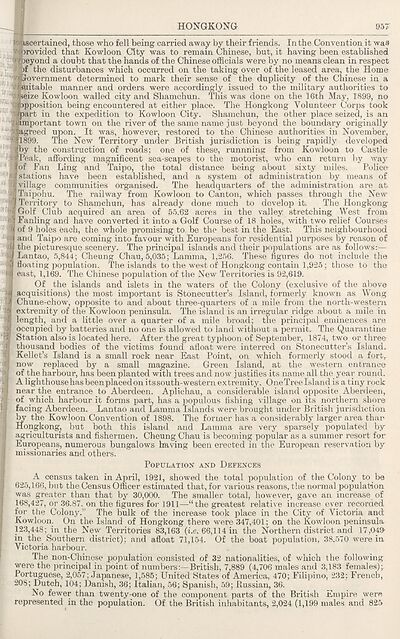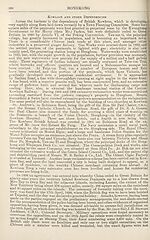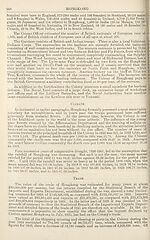1926
(1016) Page 957
Download files
Complete book:
Individual page:
Thumbnail gallery: Grid view | List view

HONGKONG
sertained, those who fell being carried away by their friends. In the Convention it was
v* >rovided that Kowloon City was to remain Chinese, but, it having been established
'H >eyond a doubt that the hands of the Chinese officials were by no means clean in respect
1 !>f the disturbances which occurred on the taking over of the leased area, the Home
“iKovernment determined to mark their sense of the duplicity of the Chinese in a
^suitable manner and orders were accordingly issued to the military authorities to
‘j||seize Kowloon walled city and Shamchun. This was done on the 16th May, 1899, no
llbpposition being encountered at either place. The Hongkong Volunteer Corps took
jJpart in the expedition to Kowloon City. Shamchun, the other place seized, is an
■Important town on the river of the same name just beyond the boundary originally
■agreed upon. It was, however, restored to the Chinese authorities in November,
'$*1899. The New Territory under British jurisdiction is being rapidly developed
>y the construction of roads; one of these, runnning from Kowloon to Castle
Peak, affording magnificent sea-scapes to the motorist, who can return by way
of Fan Ling and Taipo, the total distance being about sixty miles. Police
stations have been established, and a system oi administration by means of
village communities organised. The headquarters of the administration are at.
Taipohu. The railway from Kowloon to Canton, which passes through the New
Territory to Shamchun, has already done much to develop it. The Hongkong
« Golf Club acquired an area of 55.62 acres in the valley stretching West from
^ Fanling and have converted it into a Golf Course of 18 holes, with two relief Courses
of 9 holes each, the whole promising to. be the best in the East. This neighbourhood
and Taipo are coming into favour with Europeans for residential purposes by reason of
the picturesque scenery. The principal islands and their populations are as follows:—
Lantao, 5,844; Cheung Chau, 5,035; Lamma, 1,256. These figures do not include the
floating population. The islands to the west of Hongkong contain 1,925; those to the
eg east, 1,169. The Chinese population of the New Territories is 92,619.
Of the islands and islets in the waters of the Colony (exclusive of the above
acquisitions) the most important is Stonecutter’s Island, formerly known as Wong
Chune-chow, opposite to and about three-quarters of a mile from the north-western
extremity of the Kowloon peninsula. The island is an irregular ridge about a mile in
length, and a little over a quarter of a mile broad; the principal eminences are
occupied by batteries and no one is allowed to land without a permit. The Quarantine
Station also is located here. After the great typhoon of September, 1874, two or three
thousand bodies of the victims found afloat were interred on Stonecutter’s Island.
3 Kellet’s Island is a small rock near East Point, on which formerly stood a fortr
i now replaced by a small magazine. Green Island, at the western entrance
tfl of the harbour, has been planted with trees and now justifies its name all the year round.
A lighthouse has been placed on its south-western extremity. OneTree Island is a tiny rock
near the entrance to Aberdeen. Aplichau, a considerable island opposite Aberdeen,
of which harbour it forms part, has a populous fishing village on its northern shore
facing Aberdeen. Lantao and Lamma Islands were brought under British jurisdiction
by the Kowloon Convention of 1898. The former has a considerably larger area than
Hongkong, but both this island and Lamma are very sparsely populated by
agriculturists and fishermen. Cheung Chau is becoming popular as a summer resort for
Europeans, numerous bungalows having been erected in the European reservation by
missionaries and others.
Population and Defences
A census taken in April, 1921, showed the total population of the Colony to be
625,166, but the Census Officer estimated that, for various reasons, the normal population
was greater than that by 30,000. The smaller total, however, gave an increase of
168,427, or 36.87, on the figures for 1911—“the greatest relative increase ever recorded
for the Colony.” The bulk of the increase took place in the City of Victoria and
Kowloon. On the Island of Hongkong there were 347,401; on the Kowloon peninsula
123,448; in the New Territories 83,163 (he. 66,114 in the Northern district and 17,O^
in the Southern district); and afloat 71,154. Of the boat population, 38.570 were in
Victoria harbour.
The non-Chinese population consisted of 32 nationalities, of which the following
were the principal in point of numbers:—British, 7,889 (4,706 males and 3,183 females);
Portuguese, 2,057; Japanese, 1,585; United States of America, 470; Filipino, 232; French,
208; Dutch, 104; Danish, 36; Italian, 56; Spanish, 59; -Russian, 36.
No fewer than twenty-one of the component parts of the British Empire were
represented in the population. Of the British inhabitants, 2,024 (1,199 males and 825
sertained, those who fell being carried away by their friends. In the Convention it was
v* >rovided that Kowloon City was to remain Chinese, but, it having been established
'H >eyond a doubt that the hands of the Chinese officials were by no means clean in respect
1 !>f the disturbances which occurred on the taking over of the leased area, the Home
“iKovernment determined to mark their sense of the duplicity of the Chinese in a
^suitable manner and orders were accordingly issued to the military authorities to
‘j||seize Kowloon walled city and Shamchun. This was done on the 16th May, 1899, no
llbpposition being encountered at either place. The Hongkong Volunteer Corps took
jJpart in the expedition to Kowloon City. Shamchun, the other place seized, is an
■Important town on the river of the same name just beyond the boundary originally
■agreed upon. It was, however, restored to the Chinese authorities in November,
'$*1899. The New Territory under British jurisdiction is being rapidly developed
>y the construction of roads; one of these, runnning from Kowloon to Castle
Peak, affording magnificent sea-scapes to the motorist, who can return by way
of Fan Ling and Taipo, the total distance being about sixty miles. Police
stations have been established, and a system oi administration by means of
village communities organised. The headquarters of the administration are at.
Taipohu. The railway from Kowloon to Canton, which passes through the New
Territory to Shamchun, has already done much to develop it. The Hongkong
« Golf Club acquired an area of 55.62 acres in the valley stretching West from
^ Fanling and have converted it into a Golf Course of 18 holes, with two relief Courses
of 9 holes each, the whole promising to. be the best in the East. This neighbourhood
and Taipo are coming into favour with Europeans for residential purposes by reason of
the picturesque scenery. The principal islands and their populations are as follows:—
Lantao, 5,844; Cheung Chau, 5,035; Lamma, 1,256. These figures do not include the
floating population. The islands to the west of Hongkong contain 1,925; those to the
eg east, 1,169. The Chinese population of the New Territories is 92,619.
Of the islands and islets in the waters of the Colony (exclusive of the above
acquisitions) the most important is Stonecutter’s Island, formerly known as Wong
Chune-chow, opposite to and about three-quarters of a mile from the north-western
extremity of the Kowloon peninsula. The island is an irregular ridge about a mile in
length, and a little over a quarter of a mile broad; the principal eminences are
occupied by batteries and no one is allowed to land without a permit. The Quarantine
Station also is located here. After the great typhoon of September, 1874, two or three
thousand bodies of the victims found afloat were interred on Stonecutter’s Island.
3 Kellet’s Island is a small rock near East Point, on which formerly stood a fortr
i now replaced by a small magazine. Green Island, at the western entrance
tfl of the harbour, has been planted with trees and now justifies its name all the year round.
A lighthouse has been placed on its south-western extremity. OneTree Island is a tiny rock
near the entrance to Aberdeen. Aplichau, a considerable island opposite Aberdeen,
of which harbour it forms part, has a populous fishing village on its northern shore
facing Aberdeen. Lantao and Lamma Islands were brought under British jurisdiction
by the Kowloon Convention of 1898. The former has a considerably larger area than
Hongkong, but both this island and Lamma are very sparsely populated by
agriculturists and fishermen. Cheung Chau is becoming popular as a summer resort for
Europeans, numerous bungalows having been erected in the European reservation by
missionaries and others.
Population and Defences
A census taken in April, 1921, showed the total population of the Colony to be
625,166, but the Census Officer estimated that, for various reasons, the normal population
was greater than that by 30,000. The smaller total, however, gave an increase of
168,427, or 36.87, on the figures for 1911—“the greatest relative increase ever recorded
for the Colony.” The bulk of the increase took place in the City of Victoria and
Kowloon. On the Island of Hongkong there were 347,401; on the Kowloon peninsula
123,448; in the New Territories 83,163 (he. 66,114 in the Northern district and 17,O^
in the Southern district); and afloat 71,154. Of the boat population, 38.570 were in
Victoria harbour.
The non-Chinese population consisted of 32 nationalities, of which the following
were the principal in point of numbers:—British, 7,889 (4,706 males and 3,183 females);
Portuguese, 2,057; Japanese, 1,585; United States of America, 470; Filipino, 232; French,
208; Dutch, 104; Danish, 36; Italian, 56; Spanish, 59; -Russian, 36.
No fewer than twenty-one of the component parts of the British Empire were
represented in the population. Of the British inhabitants, 2,024 (1,199 males and 825
Set display mode to:
![]() Universal Viewer |
Universal Viewer | ![]() Mirador |
Large image | Transcription
Mirador |
Large image | Transcription
Images and transcriptions on this page, including medium image downloads, may be used under the Creative Commons Attribution 4.0 International Licence unless otherwise stated. ![]()
| Asian directories and chronicles > 1926 > (1016) Page 957 |
|---|
| Permanent URL | https://digital.nls.uk/196501381 |
|---|
| Attribution and copyright: |
|
|---|---|
| Description | Volumes from the Asian 'Directory and Chronicle' series covering 1917-1941, but missing 1919 and 1923. Compiled annually from a multiplicity of local sources and research. They provide listings of each country's active corporations, foreign residents and government agencies of all nationalities for that year, together with their addresses. Content includes: various treaties; coverage of conflicts; currencies and taxes; consular fees; weights and measures; public holidays; festivals and traditions. A source of information for both Western states and communities of foreigners living in Asia. Published by Hongkong Daily Press. |
|---|---|
| Shelfmark | H3.86.1303 |
| Additional NLS resources: |

